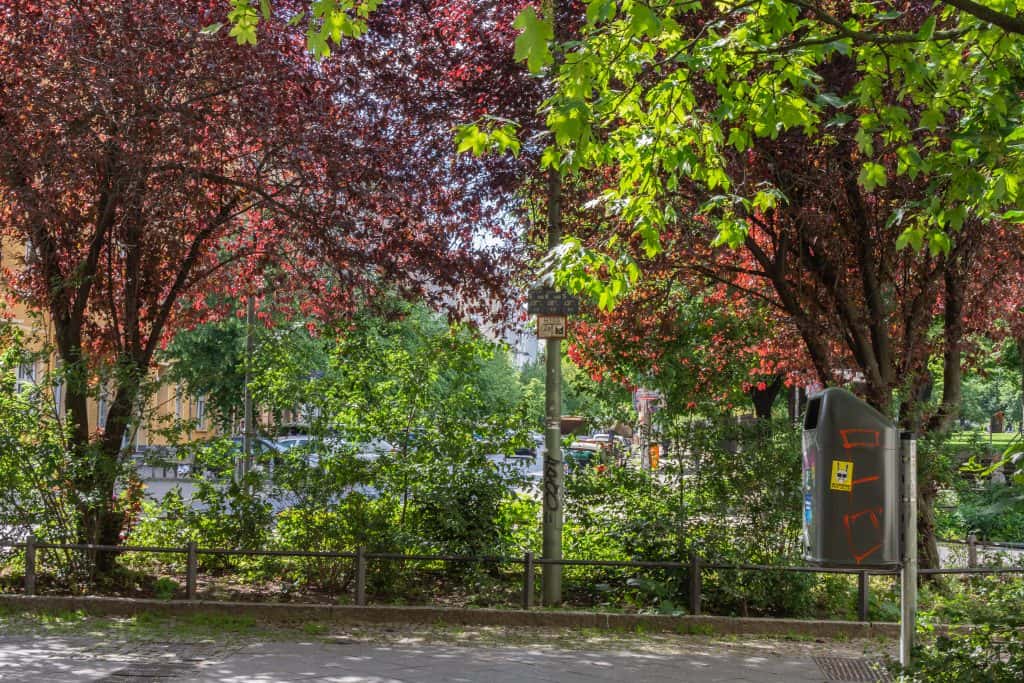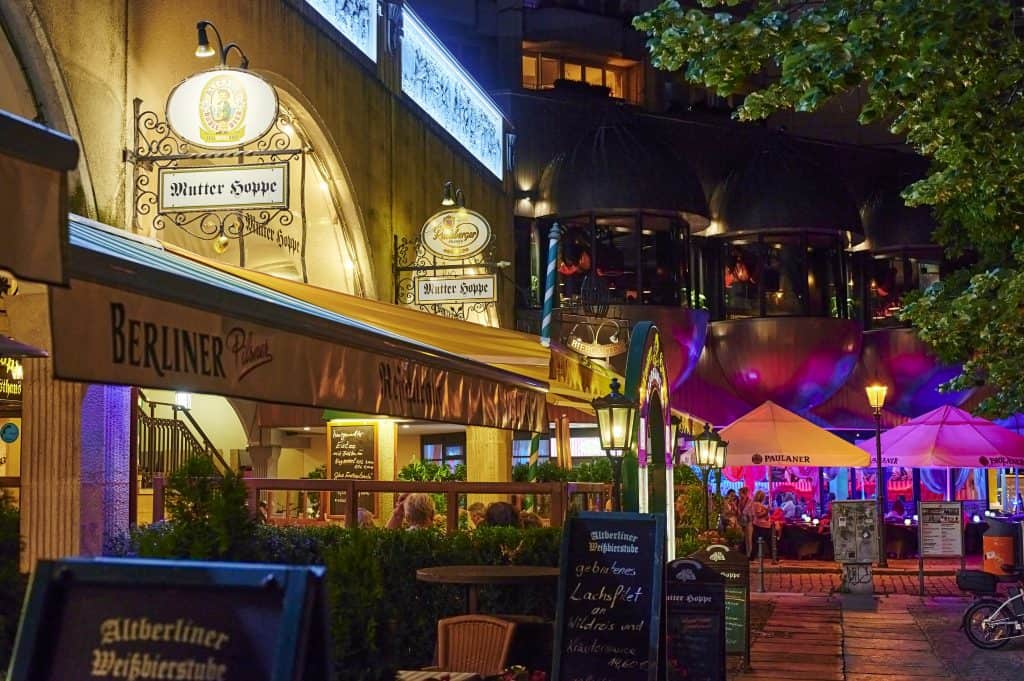If you are looking for a rental apartment in Berlin or want to buy a property here, the Berlin district of Friedrichshain is definitely a good choice. The Samariterviertel in particular, an area around the Samariterkirche church and street of the same name, is considered a Rather quiet in colorful Friedrichshain and is particularly popular with families with children. If you are interested in the Samariterviertel which is also known as the “Samariterkiez”, If you are also interested in the entire Friedrichshain district, you will find everything you need to know in the article “Buying a condominium in Berlin Friedrichshain: Real estate prices, old buildings, new construction, nightlife, residents, events & more info”.
In this article, we not only give you an overview of the development of the real estate market in Berlin’s Samariterviertel, but also provide you with lots of interesting facts and information about the popular neighborhood.
The location of the Samariterviertel in the Friedrichshain district
What you should know about the Samariterviertel
In addition to the name Samariterviertel or Samariterkiez, the popular district is also known as “Nordkiez”. Incidentally, the name “Samariterviertel” comes from the Samariterkirche church located in the area and the Samariterstraße of the same name. The name “Nordkiez” is in turn due to the fact that the neighborhood is located north of Frankfurter Allee.
The Samariterviertel has a total area of 33.8 hectares and contains a total of 263 plots. Extensive redevelopment took place here between 1993 and 2008. As a result, the population has grown significantly in recent years.
The Samariterviertel currently has around 16,700 inhabitants spread over approx. 8,400 apartments. This makes it the largest neighborhood in the Friedrichshain-Kreuzberg district. Only the neighborhood on Boxhagener Platz can boast similarly high numbers. Both residential areas are considered trendy neighborhoods in Berlin and are therefore in high demand as residential areas, especially among international buyers, young people and students.
The Samariterviertel as a neighborhood conservation area
The Nordkiez has been a social conservation area since 2021. An investigation in this regard has shown that displacement processes are taking place here due to the dynamics of the housing market, which should be prevented in order to avoid gentrification of the Friedrichhain district. The entire Samariterviertel was therefore declared a social conservation area.

What is the current real estate situation in the Samariterviertel?
The neighborhoods in the northern and southern parts of Berlin’s Friedrichshain district, including the Samariterviertel, are particularly popular residential areas. The distances to neighboring districts are short and there are good transport connections to other parts of the city. The neighborhoods also have a high density of cafés and restaurants, which makes them particularly attractive for young people and artists.
The purchase price trend for real estate in the Samariterviertel
Purchase prices for properties in the Samariterviertel have risen steadily over the past few years, as has been the case in the entire district of Friedrichshain. Between the 4th quarter of 2018 and the 4th quarter of 2022 a price increase of 41% was recorded for condominiums and 49% for houses. This means that the average purchase price for condominiums in Samariterviertel in the 4th quarter of 2022 is significantly higher than the Berlin average of € 4,320/m². However, the average purchase price for houses is different. At € 4,604/m², the Samariterviertel is slightly below the Berlin average of € 5,061/m².
How much does a condominium in the Samariterviertel cost?
In the 4th quarter of 2022, the average purchase price for a condominium in the Samariterkiez at €5,398/m². The price quoted relates specifically to Samariterstrasse 1, and therefore only represents an approximately accurate comparative value and provides a point of reference for assessing the price level. However, this value – just like the values shown in the following diagram – cannot represent the price level of the entire Samariter district.
How much does a house in the Samariterviertel cost?
The median purchase price for a house in the Samariterviertel is reported at €4,604/m² in Q4 2022. The price quoted was determined for Samariterstrasse 1 and can therefore only provide an approximately accurate indication of the purchase price level for houses in the entire Samariterviertel. This and the values shown in the following diagram can therefore not represent the price level of the entire Samariterviertel with absolute accuracy and completeness.
How are rents for properties in the Samariterviertel developing?
Rents for apartments in Berlin Friedrichshain are rising continuously. This also applies to the Samariterviertel. In Samariterstrasse 1, the average net rent has risen by 18% over a period of four years, i.e. since the fourth quarter of 2018. It can also be observed that the average net cold rent here has always been significantly higher than the Berlin average.
The increase in the average net cold rent over the past 4 years is even more significant for houses (as at December 2022). For Samariterstrasse 1, it is 37 percent. The average net rent for the houses was also always above the Berlin average.
How high is the net rent for an apartment in the Samariterviertel?
In the 4th quarter of 2022, the average net cold rent for an apartment in the Samariterviertel is approx. 13 €/m². This is the specific value determined for Samariterstrasse 1. D he rents in the Samariterviertel naturally also differ from one another and are subject to various factors. The value given here is therefore only a comparative figure. and makes no claim to conclusive accuracy. This also applies to the values shown in the following diagram, which cannot fully reflect the rent level for the Samariterviertel .
What is the net rent for a house in the Samariterviertel?
The average net cold rent for houses in the Samariterviertel is approx. 17 €/m². This figure relates to Samariterstrasse 1 and is only used here as a guide. used as a benchmark. It therefore cannot provide conclusive and complete information about the rent level for houses in the entire Samariterviertel. The values shown in the following diagram also only relate to Samariterstrasse 1 and cannot fully reflect the rent level for the Samariter district.
What are the special features of the Samariterviertel?
The Samariterviertel in Berlin Friedrichshain is characterized above all by its heterogeneity and diversity, both in terms of its architecture and the people who live here. In the following, we would like to introduce you to some particularly striking streets and residential areas of the Samariterviertel in more detail.
Samariterstrasse
Probably the most important street in the Samariterviertel runs practically right through the middle of it. The numerous trees and characteristic cobblestones in particular give the street its unmistakable style. The round 700 meters long Samariterstraße has become one of the most popular places in the eastern part of Berlin in recent years, not least due to extensive redevelopment. In the center of the street is Samariterplatz with the church of the same name, which was built in the 19th century.
The Rigaer Straße
The street, now named after the Latvian capital, was originally called Eckartsbergstraße. It runs parallel to Frankfurter Allee to the north and is home to a number of historic houses, such as the Galilee Churchwhich are now listed buildings. There are also memorial plaques for the freedom fighters Fritz Riedel and Ernst Pahnke at house numbers 64 and 96. In the past, there have been several squats on Rigaer Straße, which have since been replaced by collectively run pubs and event venues or rented apartments.
The Bänschstrasse
Named after the resistance fighter Willi Bänsch, Bänschstraße in the Samariterviertel connects Liebigstraße with Pettenkoferstraße from east to west. Until 1951, this street was known as Mirbachstraße, named after the Prussian officer of the same name. There is a wide, tree-lined footpath here that is perfect for a stroll, which is why Bänschstraße is affectionately known as the “Prachtboulevard”.

The infrastructure in the Samariterviertel
If you are looking for a rental or owner-occupied apartment in Samariterkiez, you should also find out about the infrastructure in this district in advance. Friedrichshain is generally a very pleasant part of Berlin, where many families live and there are good connections to other parts of the city as well as a wide range of restaurants. The Samariterviertel is largely located in a traffic-calmed area and has numerous children’s playgrounds.
The traffic situation and transport links
Due to the noise and environmental pollution caused by cars and trucks, traffic has been calmed in the Samariterviertel in recent years. In particular, several bollards have been installed to prevent vehicles from passing through. These measures are still the subject of heated debate among residents today, as there is no consensus as to whether the benefits of traffic calming outweigh the new problems that have arisen as a result. While on the one hand the bollards lead to more peace and safety in the demarcated areas and, above all, enable children to get to school safely, residents in neighboring areas complain about an increase in trafficwhich has shifted there due to the installation of the bollards.
The Samariterviertel is also connected to public transport. The Samariterstraße subway station on the U5 line is relatively centrally located in the neighborhood and connects it with other Berlin districts. The U5 line takes you directly from Samariterstraße to Alexanderplatz in the center of Berlin.
The demographic situation in the Samariterviertel
The Samariterkiez is a heavily built-up Berlin district with residential areas of simple and medium quality from the Wilhelminian era. The population structure is subject to constant change: while there is a steady influx from other parts of the city, long-established residents are gradually moving to other residential areas as the district is redeveloped and modernized.
In December 2022, around 22,400 people live in the Samariterviertel. The The average age of the population is around 35 years old. According to the final report of the “Samariterviertel 2020 social study” by the Friedrichshain-Kreuzberg district authority dated 18.11.2020 Around 84 percent of residents are adults. The age group of children and minors amounts to 15 percent, and only around 10 percent of the residents of the Samariterviertel are people of pre-retirement or retirement age, i.e. aged 55 or over. The population of the Samariterviertel is made up of 48 percent women and 52 percent men.
For children in particular, the neighborhood is ideally equipped with playgrounds and childcare facilities. Young people currently still lack appropriate leisure facilities within the neighborhood. Due to the high level of development, there is now also little space for green areas.
Which parties are represented in the Samariterkiez?
The distribution of parties in Friedrichshain-Kreuzberg and Prenzlauer Berg Ost can be used as a basis for the party political situation in Samariterviertel. In the 2021 federal election, the Greens were by far the strongest party here with 36.7% of the second votes. The SPD and DIE LINKE were also strongly represented with 19.2% and 18.1% of the second votes respectively. The CDU achieved 7.0% of the second votes, while the FDP still managed 6.3%. The AfD achieved 4.1% of the second votes.
Is the Samariterviertel also suitable for families with children?
One of the most important features of the Nordkiez is certainly its child and family friendliness. There are numerous playgrounds here and the traffic calming means that children can move around the district relatively safely and unmolested. However, the demand for primary school places is not yet fully met and there is also a lack of green spaces and suitable leisure activities for young people. However, childcare for children under the age of 7 is above average. Due to the attractiveness of the district, more and more families or people with existing family plans are moving here.
These shopping opportunities are available in the Nordkiez
Samariterkiez is home to all the main stores, so that everything you need for everyday life can be bought quickly and conveniently nearby. The selection ranges from supermarkets to organic markets and thus satisfies the heterogeneity of the neighborhood’s residents and their tastes. There are also many unusual stores and stores in the neighborhood, such as special second-hand stores.
Diversity of gastronomy in the neighborhood
The gastronomic offerings in the Samariterviertel are surprisingly diverse. As in the whole of Berlin Friedrichshain, you will find various bars and clubs on almost every corner. But there are also plenty of original pubs and great restaurants in the Samariterviertel. The selection ranges from vegan and gluten-free baked goods to various spirits and traditional Berlin cuisine. There is guaranteed to be something for every taste!

Our Samariterviertel tips for explorers
Like every residential area, the Samariterkiez in Berlin has some particularly beautiful corners. The following tips will tell you where you can relax in the Samariterviertel district of Berlin Friedrichshain and where you can buy the most unusual things.
Tip 1: The Samaritan Church
The church was built from bricks The plans for the building in the style of the Brandenburg Brick Gothic were drawn up by the architect Gotthilf Ludwig Möckel. The church was extensively restored between 1991 and 1994 and has been a listed building ever since.
The Samariterkirche forms the heart of the district and gave it its name. At the time of the division of Berlin and Germany, blues masses were held here, sending a clear signal of opposition to the GDR government at the time. In this context, meetings and demonstrations by opposition groups against the GDR regime also took place on the church grounds.
The Samariterkirche is still a popular meeting place for the residents of the neighborhood. It is located in the middle of Bänschstraße, which is particularly pleasant for a stroll. The square around the church invites you to linger and reflect.
Tip 2: Forckenbeckplatz
This is a 24,300 square meter green space named after the former mayor of Berlin, Maximilian Franz August von Forckenbeck. The area is used as a sunbathing lawn as well as for walking or playing basketball. Children in particular can let off steam on the playground or in the paddling pool. The square provides space for encounters between different generations, social milieus and areas of interest. A real insider tip for relaxing, chatting, barbecuing and playing!
Tip 3: Discover unusual and trendy stores in the Samariterviertel district
The Kiez has many surprises in store once you start exploring the streets. There are unusual vintage stores here, such as “Legends Vintage”, or the café “Ohlala”, which offers French patisserie, but also vegan and gluten-free on request. There are also many small stores, pubs and bars in the Samariterviertel, whose diversity makes the colorful and inimitable flair of this residential area particularly noticeable.
Conclusion
If you are looking for a nice property in the heart of Berlin, the Samariterviertel is a good choice. Most of the houses and apartments have been renovated and Berlin Friedrichshain is generally a good district to live in, especially for families. The value of real estate in Samariterviertel is growing steadily and condominiums in Samariterviertel in particular have an above-average growth rate compared to Berlin as a whole. The convenient location with good transport links and good infrastructure make the district particularly attractive for newcomers. The heterogeneity of the neighborhood and the people who live here make the Samariterviertel an interesting and varied place to live in Berlin.



